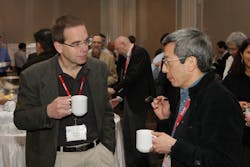BIOPHOTONICS ROADMAPPING/CONFERENCES AND WORKSHOPS: Bio-optics lollapalooza in Quebec: Five events in one
What happens when five biophotonics-focused events take place in the same city during the same week? We'll find out soon, when Biophotonics Week takes place Sept. 22–30, 2010 in Quebec City, Canada.
"This constellation will never happen again," says Brian Wilson, professor of medical biophysics at the University of Toronto, and biomedical theme leader at the Canadian Institute for Photonic Innovations. He notes that "the International Congress on Biophotonics (ICOB, Sept. 25–27) is the lynchpin" for this coordination of conferences and workshops. The concurrent events include:
- The 11th Optics Within Life Sciences (OWLS), an academic conference focused on therapeutics, diagnostics, and analytics that will make its North American debut this year (it has been produced for more than 20 years in Asia and Europe) (Sept. 28–30)
- Biophotonics School, a hands-on experience for graduate students, junior scientists, and those new to bio-optics (Sept. 24–27)
- The second Frontiers in Neurophotonics, a traditional scientific conference, focused on the applications of photonics to clinical and investigative neurosciences, that launched in 2008 in France (Sept. 22–24)
- Biophotonics in Infectious Disease, a bilateral workshop to develop strategic innovation partnerships between California and Canada (Sept. 22–24)
The various events will be held at two locations: The former two will take place at the University of Laval, and the latter two at the Hotel Chateau Laurier.
ICOB "is the pivotal meeting that generated Biophotonics Week," says Wilson, who co-organized the ICOB (which launched in 2008) along with University of California–Davis professor Dennis Matthews. Matthews directs the National Science Foundation-funded Center for Biophotonics, Science & Technology (CBST), which wanted to run a conference but concluded that the industry does not need yet another scientific event. The organizers explain that the ICOB was conceived instead to gather thought leaders from around the world representing academia (researchers and educators), industry, medicine, and government agencies, to create a strategic roadmap for the future of biophotonics research, technology development, and education. The rationale was to provide guidance and direction to further biophotonics science and technology development into those areas of greatest need for creative and innovative solutions to "grand challenges" in the life sciences and medicine. In 2008, the four-day congress drew 120 invited participants from around the world to share recent seminal science, review current and projected clinical needs in key healthcare areas, and discuss the best focus for future advances as well as strategies to achieve them.
Results from the inaugural congress
Roadmaps for the original ICOB themes–advanced microimaging; probes, sensors, and assays, and clinical biophotonics–are not quite finished; Wilson says that the event generated an incredible volume of material.
But the congress also generated a few clear messages. One is the need to focus biophotonics on some very major challenges, including noninvasive measurement of blood glucose, nonantibiotic treatment of infections, bringing laboratory diagnostics to the point of care, the creation of better methods of treating presbyopia, providing therapies for metastatic cancer, devising new strategies for emergency medicine for rapid diagnosis, and field portable imaging.
Another message expressed repeatedly centers on the need to develop funding initiatives that encourage large-scale international partnering on major biophotonics efforts. At present, international scientist exchange programs are readily available, but the time is right for internationally funded research partnerships and international biophotonics theme-based Centers of Excellence or Research Networks.
Finally, ICOB 2008 participants identified as one of the greatest barriers to creating new medical devices and tools the lack of a path for funding the translation of technology from bench to bedside. On the technology readiness levels (TRL) scale of 1–10, with 1 being concept and 10 being marketable device, most fall victim to the "valley of death" at TRL ~3–7. Although there are many reasons for this, the biggest hurdle is the lack of NIH-style government or private funding available for advancing technology to the commercialization forefront at the appropriate, industry-driven pace. The biophotonics community now hopes to focus on developing initiatives to mitigate this substantial barrier to innovation and for greater human health impact.
Three new themes
Like the 2008 congress, this year's ICOB is also organized around three themes–and these themes were selected to leverage the subject matter of the colocating events. They are neurosciences, point-of-care/infection, and drug discovery and development. According to Wilson, a number of participants from Frontiers in Neurophotonics and Biophotonics in Infectious Disease will feed into ICOB.
We'll be watching for the outcome of the Biophotonics Week in general and ICOB 2010 in particular. Meanwhile, you can find out details at http://biophotonicsweek.biophotonicsworld.org.
About the Author

Barbara Gefvert
Editor-in-Chief, BioOptics World (2008-2020)
Barbara G. Gefvert has been a science and technology editor and writer since 1987, and served as editor in chief on multiple publications, including Sensors magazine for nearly a decade.
